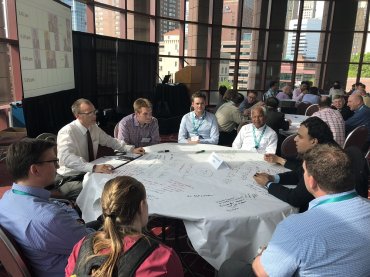
At the annual meeting of the Society of Tribologists and Lubrication Engineers last month, technical presentations, as usual, were the stars of the event. More than 500 were given over the four-day event – most by researchers from industry and academia telling audiences of one or two dozen about experiments into the use of various base stocks and chemical additives, surface engineering, methods of wear and numerous other topics.
One session was different than most. On the afternoon of May 23, several dozen attendees gathered in a lounge off in another wing of the convention center, dividing themselves amongst several large round tables. There were no presentations here. Instead, each table had a leader who asked a single question or posed a lubrication problem. Those at the table then spent the next half hour trying to solve it.

Photo courtesy of Tim Sullivan
Participants at discussion session during STLEs annual meeting in Minneapolis May 23.
The organizer of this session, Hannes Grillenberger, of Schaeffler Technologies AG & Co., explained that its purpose is more about the process of the discussion than the content.
I do want the hosts to have the possibility of gaining some ideas that may be helpful in the subject they are working on, he said. They are making a contribution by posing a question.
But the other important part of this is the perspective of the attendees. They get an opportunity to participate in a free-flowing discussion among people from different disciplines. That can be a very effective way of solving problems, but its something that happens too seldom in our industry – either because companies dont create the opportunities for it or you dont have the diversity of backgrounds that we have here, for example.
Chris DellaCorte, of the United States National Aeronautics and Space Administrations Glen Research Center, hosted one table and posed a question about models used to predict surface damage and disintegration of components such as bearings, gears and cams. Surface damage is a common occurrence in industry, so industry tries to predict when that damage will occur and the ability of lubricants to forestall it.
There are questions, though, about the practical benefits of these models. DellaCorte asked, Are rolling contact fatigue life models good enough?
One of his groups identified numerous shortcomings in the use of such models. One noted that some give off inconsistent results. Another noted that tests for ability to prevent rolling contact fatigue often run on apparatuses with multiple bearings. The models usually exert loads on bearings that are equal and constant, he said. But in real life the loads are neither equal nor constant.
A third person added that too little data about rolling contact fatigue exists to build sound models. A fourth noted that bearings often fail for reasons other than rolling contact fatigue. At the end of his session, DellaCorte concluded that industry should perhaps try to take account of those phenomenon.
Maybe we should de-emphasize fatigue life models and concentrate on operating life, he said.
Manfred Jungk, an independent consultant, hosted another table and sought help explaining why experiments with tungsten disulfide nanochemicals found that they failed to significantly reduce wear of lubricated components. His question: Do nanoparticles disappear in the valleys of surface roughness or do the valleys provide a reservoir?
Attendees suggested a number of potential reasons that the particles might not provide the hoped for protection. In the end, they reinforced what we found in our research, Jungk said.
Attendees at the panel discussions included academics and members of industry; tribologists, engineers and chemists; individuals from lubricant and additive suppliers, equipment manufacturers and engineering firms. Grillenberger added that he was pleased by that diversity as well as the range of ages and experience in the group.
This can be an especially rich experience for young people who are getting a chance to discuss face to face with people who are experienced and who are true leaders in their field, he said.